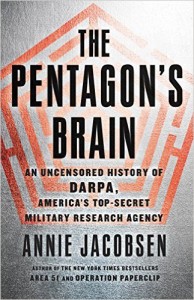
If you’re familiar with the history of the computer industry, you’re no doubt aware that the Internet was conceived and developed by a U.S. Government agency called DARPA (the Defense Advanced Research Projects Agency). That’s the arm of the Pentagon responsible for top-secret military research.
You may also know that the same agency invented GPS, the Global Positioning System. Chances are, though, that you don’t know that DARPA also invented drones both big and tiny, Agent Orange, the M16 Assault Rifle, sophisticated sensor technology, the F117A stealth fighter jet, MIRVs (Multiple Independently Targetable Reentry Vehicles) that carry nuclear weapons, the Ballistic Missile Early Warning System, robotic soldiers — and a slew of other military weapons systems, most of them still top secret.
You may also know that the same agency invented GPS, the Global Positioning System. Chances are, though, that you don’t know that DARPA also invented drones both big and tiny, Agent Orange, the M16 Assault Rifle, sophisticated sensor technology, the F117A stealth fighter jet, MIRVs (Multiple Independently Targetable Reentry Vehicles) that carry nuclear weapons, the Ballistic Missile Early Warning System, robotic soldiers — and a slew of other military weapons systems, most of them still top secret.
The Pentagon’s Brain: An Uncensored History of DARPA, America’s Top-Secret Military Research Agency by Annie Jacobsen (2015) 577 pages ★★★★★
Remember Total Information Awareness, the predecessor to the massive data collection programs of the NSA that Edward Snowden revealed? DARPA was responsible for that one, too. The agency’s work also gave birth to less lethal technologies, including “real-time video processing, noise reduction, image enhancement, and data compression.” It’s difficult to exaggerate the impact of this little-known agency.
All this comes to light in the pages of journalist Annie Jacobsen’s The Pentagon’s Brain, the first full-length study of America’s secretive military research agency.
DARPA’s mission
DARPA was created by President Dwight D. Eisenhower over the strenuous objections of the Joint Chiefs of Staff and just about everyone else in the military establishment. “Its mission is to create revolutions in military science and to maintain technological dominance over the rest of the world.” No doubt there are many in the military and in conservative circles who are thrilled at how successful the agency has been in fulfilling its mission, their original unhappiness notwithstanding. The rest of us should be scared. Very scared.
With its origins in the debates over the use of the hydrogen bomb and the policy of Mutual Assured Destruction in the 1950s, DARPA’s R&D programs have consistently been found on the far frontiers of military science. Among its least savory efforts (among a great many) were a project in 1958 to shield the United States from Soviet attack by exploding nuclear weapons in the upper atmosphere and the use of the herbicide Agent Orange to defoliate the South Vietnamese forests sheltering Vietcong troops. DARPA scientists actually did detonate nuclear weapons in the atmosphere — and you know the story of Agent Orange.
Unpleasant surprises
The Pentagon’s Brain was the product of exhaustive research. Much of the book is based on formerly classified materials that have only lately come to light. Author Annie Jacobsen turned up startling new information in the course of her research. For example, she learned that the world came even closer to Armageddon during the Cuban Missile Crisis than anyone outside top government and military circles was aware: “four nuclear weapons were detonated in space” during those tense days, when the U.S. and the Soviet Union stood on the brink of total nuclear war. (Two of those were the aforementioned bombs sired by DARPA.)
Though born in the grimmest days of the Cold War, DARPA’s work for more than a decade focused on the war in Vietnam. (The agency was originally called just ARPA until Congress got into the act.) That conflict led to the development of the M16 rifle and many other, less celebrated weapons of war. But much of the work involved the social sciences, subcontracted to the RAND Corporation, a name that will be familiar to anyone who lived through those times.
ARPA contractors working for RAND helped to justify the notorious Strategic Hamlets program in which South Vietnamese peasants were forcibly removed from their villages and their lands and moved into heavily guarded new settlements. In fairness, the first round of ARPA social scientists found that the Strategic Hamlets were alienating peasants, but their findings were simply rejected by Pentagon leaders and more amenable researchers hired. Similarly, “the agency did not want to hear that the Vietcong could not be defeated. [Administrators] took the position that [the social scientists] had gone off the rails.”
The electronic battlefield
The high profile of many DARPA inventions notwithstanding, what may be its most significant creation was a “system of systems” that is known today as the electronic battlefield. Jacobsen calls it “the most revolutionary piece of military technology of the twentieth century, after the hydrogen bomb.” This concept encompasses the use of remotely piloted attack drones and technology that enhances the ability of individual soldiers. Ultimately, DARPA research is expected to extend the concept into “transhumanism — the notion that man can and will alter the human condition fundamentally by augmenting humans with machines and other means.” One such effort is the DARPA exoskeleton, which bears an uncanny resemblance to The Terminator and Robocop. Another is an effort to “allow future ‘soldiers [to] communicate by thought alone.”
The Pentagon’s Brain is crammed with chilling examples of the brave new world envisioned by DARPA scientists. I would like to think that every member of Congress would read this book — and then take a much more careful look at funding for the Pentagon. Fat chance, eh?
About the author
Annie Jacobsen is the author of three previous nonfiction books about the Pentagon. One relates the story of Operation Paperclip that brought Werner von Braun and other Nazi scientists to the U.S. following World War II. Another is a history of Area 51, which may be the best known and most notorious American military base in existence.
For more great reading
This is one of the many good nonfiction books about national security.
This book is included in my lists of My 10 favorite books about business history and 10 best books about innovation.
You may enjoy browsing through 20 top nonfiction books about history.
For more good books on the history of the US, see Top 20 popular books for understanding American history.
And you can always find my most popular reviews, and the most recent ones, on the Home Page.



























I learned ALL about Darpa in grad school. The info was brain-rivetingly horrible.